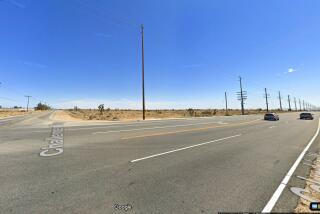Picking Up the Pace
These are the sort of traffic cops you want to see in the rearview mirror.
In an unusual tactic, the California Highway Patrol has assigned 14 motorcycle officers and one patrol car the responsibility of keeping traffic moving on a 5 1/2-mile stretch of the Ventura Freeway in the San Fernando Valley.
They are not there to write tickets or fill out accident reports.
Think of them as motorized traffic herders whose goal is to maintain the flow and prevent drivers from straying from the pack onto the shoulder.
Their job on the freeway, between Lankershim and Van Nuys boulevards, is to help disabled vehicles, move minor fender-benders out of traffic lanes and clear the annoying freeway flotsam that causes drivers to swerve around debris.
The one-year CHP pilot program is part of Gov. Gray Davisâ $5.2-billion Traffic Congestion Relief Plan unveiled in April.
Funded with $9.7 million, the CHPâs Focused Congestion Management Project assigned 96 officers to traffic hot spots around the state.
The Valley unit is the only one in Los Angeles County. Riverside County has 21 officers and Ventura County has two.
Fifteen officers cover the 11-mile freeway circuit from 5:30 a.m. to 8 p.m.
Cruising back and forth, the officers survey a stretch of the 101 that Caltrans has identified as one of the stateâs 20 major congestion points, CHP Sgt. Michael Poore said.
The CHPâs Southern Division, which covers the Greater Los Angeles area, is home to 14 of those clogged freeway arteries.
On a recent Friday morning, traffic was speeding along smoothly. Not more than five minutes after entering the freeway, CHP Officer Wendy Kozlowski stopped her patrol car to assist a silver Cadillac that had pulled onto the shoulder.
âHe panicked because some lights came on his dash,â she said. A few moments later, the nervous driver cautiously left the freeway, hazard lights blinking.
Easing back into traffic lanes, Kozlowski passed several colleagues on CHP-issued BMW motorcycles.
One stopped to talk with the driver of an old pickup truck who wanted to adjust the gardening equipment that was about to tumble out. On the other side of the freeway, an officer checked on a big rig stopped near an offramp.
The CHP warns motorists not to park on the shoulder unless itâs an emergency, because other cars could drift over and hit them. Cars stopped on the side of the highway also draw looky-loos, triggering a domino effect that slows traffic.
Why do motorists park on the shoulder?
âI can give you a list a mile long,â motorcycle Officer Robin Johnson said. Impromptu cell phone chats and searches for items dropped inside the car are but a few of the reasons.
âItâs absolutely amazing, if they realized how people can drift onto the shoulder and hit them,â she said, as traffic whizzed past.
Just after 9 a.m., a big rig stopped on what the CHP calls a gore point, the V-shaped area between the westbound freeway lanes and the offramp.
âHe actually pulled over because heâs lost and heâs checking his map,â Johnson said, after telling the trucker to get back onto the highway.
Since the pilot program began in November, the CHP has slashed response times to calls in the target area. Previously, response time averaged 21 minutes, but that was cut to 4 to 5 minutes in November and December, Poore said.
*
Caltrans said it is monitoring the effectiveness of the added officers. Though motorists are mainly concerned with faster driving speeds, that is not what officials are gauging, said Tom Choe, who oversees the regionâs Caltrans freeway operations.
Instead, they will keep track of response times by the CHP, the amount of time it takes to clear an incident and the number of incidents, all of which cause congestion.
If there is a minor accident or stalled car, the CHP has to be called out, fight the residual traffic backup from that problem and clear the site, Choe said.
An accident that blocks one lane for 15 minutes or less, costs motorists about $2,000 in lost job time, productivity and other expenses, according to Caltrans estimates.
With 897 such incidents in November and 1,029 in December on this stretch of the freeway, the estimated financial toll is substantial, Choe said.
The biggest benefit will be to deter drivers who swerve across several lanes to make a last-minute freeway exit, which causes slowing in all lanes, and to sweep the shoulders of cars making nonemergency stops, he said.
For those who feel their heart rate jump when they see a CHP officer, the new program is a refreshing change.
*
âYou OK?â Kozlowski asked, knocking on the passenger-side window of a brown Chevy truck stopped on the shoulder near Vineland Avenue.
âI think it overheated; my temperature gauge was jumping,â answered a surprised Kristen Gass of Valencia, who was frantically dialing her cell phone.
A few minutes later, Kozlowski gently nudged the truck, with her patrol carâs push bumper, along the shoulder to the next offramp and a safe spot where a tow truck can take over.
âIâve never been on the side of the freeway before,â Gass said. âIt was nice to have someone here.â
More to Read
Sign up for Essential California
The most important California stories and recommendations in your inbox every morning.
You may occasionally receive promotional content from the Los Angeles Times.










